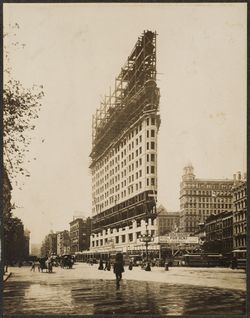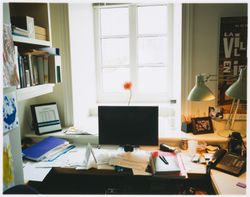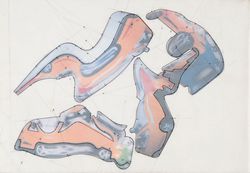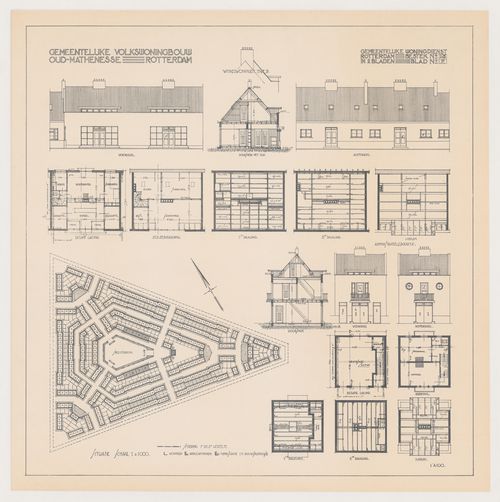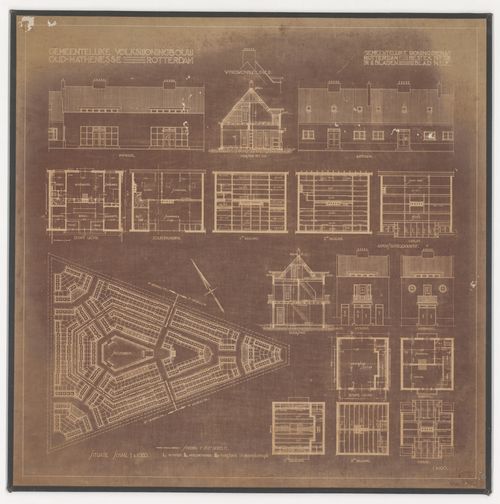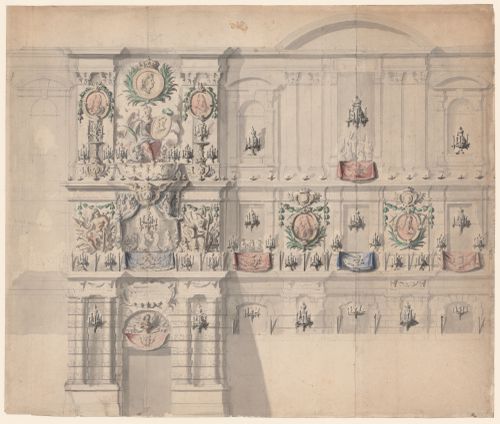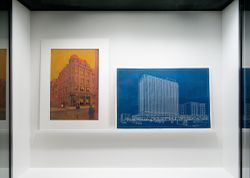Architects of the Image: Photography in the Heroic Age of Construction explores the relationships between camera images and the making of large-scale architectural and engineering structures that stirred public imagination in the first hundred years of photography. The exhibition is predicated on the notion of the photographer as architect, an analogy that suggests(...)
11 October 1995 to 4 February 1996
Architects of the Image: Photography in the Heroic Age of Construction
Actions:
Description:
Architects of the Image: Photography in the Heroic Age of Construction explores the relationships between camera images and the making of large-scale architectural and engineering structures that stirred public imagination in the first hundred years of photography. The exhibition is predicated on the notion of the photographer as architect, an analogy that suggests(...)
When the Canadian Centre for Architecture building was conceived and designed as an addition to the nineteenth-century Shaughnessy House, it also became an addition to the CCA’s extensive collection. Accordingly, the inaugural exhibitions in the new building in 1989 included a display on the Building and Gardens. The CCA, which plays an influential role in furthering(...)
Hall cases
22 April 2015 to 30 November 2015
The CCA in Photographs, 1987–2015
Actions:
Description:
When the Canadian Centre for Architecture building was conceived and designed as an addition to the nineteenth-century Shaughnessy House, it also became an addition to the CCA’s extensive collection. Accordingly, the inaugural exhibitions in the new building in 1989 included a display on the Building and Gardens. The CCA, which plays an influential role in furthering(...)
Hall cases
articles
Journeys and translation
In this lecture, Amy Kulper locates architecture’s “digital turn” in 1988, when Thomas Knoll invented Photoshop. Originally developed as an image-editing software, Photoshop fit neatly within the long history of optical correction in the discipline. Yet its ubiquity today also prompts new questions. Does Photoshop simply introduce logics of adjustment, correction, and(...)
Paul Desmarais Theatre
9 June 2016, 6pm
Amy Kulper: Architecture’s Digital Turn and the Advent of Photoshop
Actions:
Description:
In this lecture, Amy Kulper locates architecture’s “digital turn” in 1988, when Thomas Knoll invented Photoshop. Originally developed as an image-editing software, Photoshop fit neatly within the long history of optical correction in the discipline. Yet its ubiquity today also prompts new questions. Does Photoshop simply introduce logics of adjustment, correction, and(...)
Paul Desmarais Theatre
DR1984:0509
Description:
- A legend at the bottom of the drawing indicates that solid lines represent houses (WONINGEN), single hatching represents shop/houses (WINKELWONINGEN), and cross-hatching represents administration and fire station buildings (ADMINISTRATIE EN BRANDSPUITHUISJE).
architecture
printed 1922-1923
Site plan, floor, roof and framing plans, sections, and elevations for Oud-Mathenesse Housing Estate, Rotterdam, Netherlands
Actions:
DR1984:0509
Description:
- A legend at the bottom of the drawing indicates that solid lines represent houses (WONINGEN), single hatching represents shop/houses (WINKELWONINGEN), and cross-hatching represents administration and fire station buildings (ADMINISTRATIE EN BRANDSPUITHUISJE).
architecture
DR1984:0510
Description:
- A legend at the bottom of this drawing indicates that solid lines represent houses (WONINGEN), single hatching represents shop/houses (WINKELWONINGEN), and cross-hatching represents administration and fire station buildings (ADMINISTRATIE EN BRANDSPUITHUISJE).
architecture
printed 1922-1923
Site plan, floor, roof, and framing plans, sections and elevations for Oud-Mathenesse Housing Estate, Rotterdam, Netherlands
Actions:
DR1984:0510
Description:
- A legend at the bottom of this drawing indicates that solid lines represent houses (WONINGEN), single hatching represents shop/houses (WINKELWONINGEN), and cross-hatching represents administration and fire station buildings (ADMINISTRATIE EN BRANDSPUITHUISJE).
architecture
DR1967:0012
Description:
The drawing shows an elevation of the Porte Jean Goujon (now known as the Porte Barbet de Jouy) on the southern, quai-side façade of the Louvre, as well as part of the façade to the east of the portal. On the ground floor, candelabras line the windows and niches. The entry portal features a sculptural bust – likely a representation of Louis XIV – and a red banner with the king’s coat of arms. Above the portal’s tympanum is a large ovoid cartouche with faint script in black chalk that may read « Plate pour l’inscription, » indicating that the text had not yet been finalized at the time of the drawing’s creation. The heavily-decorated middle register features two over-life-size mythical and allegorical figures on either side of a balcony. To the left is Hercules, with his club, and to the right is an allegorical representation of Bellona. The balcony is hung with a blue tapestry woven with the king’s interlocking L monogram. Blue curtains with fleurs-de-lys hang over the balcony, revealing the revelers inside the building. These ornamental elements continue along the façade, which is hung with two large, circular portrait reliefs that likely show Louis XIV’s son, Grand Dauphin Louis, and grandson, Louis, the Duke of Burgundy, who was the father of the Duke of Brittany whose birth was being celebrated. Green watercolor paint is used to highlight the foliage festoons and palms that frame the portraits. On the top register of the portal is a seated allegorical figure holding a palm and a portrait, perhaps of the infant Louis, Duke of Brittany. Above her is a large, crowned medallion with the profile of Louis XIV in the guise of a Roman emperor surrounded by green palms. On either side of this central scene are large candelabras and circular portraits of the Grand Dauphin and the Duke of Burgundy. The architectural elements of the façade are carefully drawn in black chalk and faithfully render the architecture of the Louvre in the early eighteenth century.
temporary architecture
circa 1704
Design for ceremonial decorations at the Louvre
Actions:
DR1967:0012
Description:
The drawing shows an elevation of the Porte Jean Goujon (now known as the Porte Barbet de Jouy) on the southern, quai-side façade of the Louvre, as well as part of the façade to the east of the portal. On the ground floor, candelabras line the windows and niches. The entry portal features a sculptural bust – likely a representation of Louis XIV – and a red banner with the king’s coat of arms. Above the portal’s tympanum is a large ovoid cartouche with faint script in black chalk that may read « Plate pour l’inscription, » indicating that the text had not yet been finalized at the time of the drawing’s creation. The heavily-decorated middle register features two over-life-size mythical and allegorical figures on either side of a balcony. To the left is Hercules, with his club, and to the right is an allegorical representation of Bellona. The balcony is hung with a blue tapestry woven with the king’s interlocking L monogram. Blue curtains with fleurs-de-lys hang over the balcony, revealing the revelers inside the building. These ornamental elements continue along the façade, which is hung with two large, circular portrait reliefs that likely show Louis XIV’s son, Grand Dauphin Louis, and grandson, Louis, the Duke of Burgundy, who was the father of the Duke of Brittany whose birth was being celebrated. Green watercolor paint is used to highlight the foliage festoons and palms that frame the portraits. On the top register of the portal is a seated allegorical figure holding a palm and a portrait, perhaps of the infant Louis, Duke of Brittany. Above her is a large, crowned medallion with the profile of Louis XIV in the guise of a Roman emperor surrounded by green palms. On either side of this central scene are large candelabras and circular portraits of the Grand Dauphin and the Duke of Burgundy. The architectural elements of the façade are carefully drawn in black chalk and faithfully render the architecture of the Louvre in the early eighteenth century.
temporary architecture
Starting from... People
One of the markers of modernity from the eighteenth century onwards is the emergence of “the people” as a respected political entity. In response, architects have advocated for the transformation of cities, explored new technologies, pioneered design discourses, and engaged in heated cultural conflicts—all in the name of the people. During this time, fictional, abstracted(...)
Hall cases
5 October 2011 to 22 January 2012
Starting from... People
Actions:
Description:
One of the markers of modernity from the eighteenth century onwards is the emergence of “the people” as a respected political entity. In response, architects have advocated for the transformation of cities, explored new technologies, pioneered design discourses, and engaged in heated cultural conflicts—all in the name of the people. During this time, fictional, abstracted(...)
Hall cases
articles
A Story of Encounters
Forces of Friction
Series
AP012.S1
Description:
La série documente les projets architecturaux de Michaud depuis ses années d'études dans les années 1940 jusqu'à environ 1981. Environ 84 projets sont représentés principalement par des dessins et quelques documents textuels.
1946-1981, surtout 1950-1969
Projets d'étudiant et projets de l'architecte
Actions:
AP012.S1
Description:
La série documente les projets architecturaux de Michaud depuis ses années d'études dans les années 1940 jusqu'à environ 1981. Environ 84 projets sont représentés principalement par des dessins et quelques documents textuels.
Série 1
1946-1981, surtout 1950-1969
